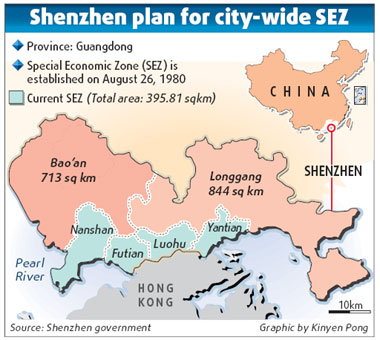The Shenzhen government has drawn up a blueprint to expand the country's first special economic zone (SEZ) to the whole city - as a restructuring strategy to increase its competitiveness amid the economic downturn.

"Legislators are working on the proposal to expand the scope of Shenzhen SEZ to the whole city, but it needs the approval of the State Council," an official with the legislative affairs office of the Shenzhen People's Congress, who did not want to be identified, told China Daily Thursday.
Earlier this month, the State Council added the city to the list of two more areas to pilot comprehensive reforms. But "important reforms regarding the scope of the SEZ, land and finance should get approval case by case," the document specifies.
If the proposal is approved, Bao'an and Longgang districts, which make up four-fifths of the city's land mass, will become part of the SEZ, whose area will swell from the current 395.81 sq km to more than 1,900 sq km.
"In the face of the economic downturn, the SEZ has been retooling its strategy to bring in more high-tech enterprises in place of labor-intensive industries.
The economic restructuring will sharpen its competitive edge," explained Cheng Jiansan, an economist with the Guangdong Academy of Social Sciences.
In the land-strapped SEZ, where the government also needs to develop commercial facilities and green areas for residents, IT enterprises like Huawei have hardly any room for expansion, he said.
Huawei is moving its production base to Longgang district, which is not yet part of the SEZ. "But, if in the future, Longgang district becomes part of the SEZ, IT companies like Huawei will be able to enjoy preferential policies like lower income tax," he said.
The city can also have balanced development with the removal of long-existing policy and legal differences inside and outside the SEZ, scholars said.
Bao'an and Longgang are separated from the four districts in the SEZ by a 100-km-long border although in recent years, the government has allowed entry to the SEZ with special passports.
But "if the merger is approved, the two districts would enjoy the same legislation, same urban planning and same infrastructure. The integration will allow the city to achieve balanced development," said Guo Wanda, vice-president of the China Development Institute, a government think tank.
For example, people living outside the SEZ cannot enjoy the superior education and healthcare resources inside the zone.
Also, the Shenzhen government tended to be partial to the SEZ, Cheng said. Likewise, the infrastructure and industrial planning in the two districts were often not in tune with the SEZ.
Cheng said the Zhuhai and Shantou SEZs face a similar problem and "if Shenzhen's proposal for expansion is approved, I believe Zhuhai will try to go down the same path".
Linus Yip, strategist at Hong Kong-based First Shanghai Securities, believes the expansion of Shenzhen SEZ will also benefit development in the Pearl River Delta region (PRD).
Yip also said it is just a matter of time for Shenzhen to further expand and combine with Hong Kong. "The two cities are, at the moment, quite closely correlated in terms of economic activities, and it will be irresistible for them to merge," Yip said, adding a merger would bring synergy.
Since 1980, the government has set up five SEZs (Shenzhen, Zhuhai and Shantou in Guangdong province, Xiamen in Fujian province, and Hainan Island).
In 2005 and 2006, the State Council designated Shanghai Pudong and Tianjin Binhai as comprehensive reform pilot areas, with Shenzhen added to the list this month.
On May 6, Shanghai Pudong secured approval to expand by merging with Nanhui District, to facilitate its plan of becoming an international financial and shipping center.
(China Daily May 22, 2009)